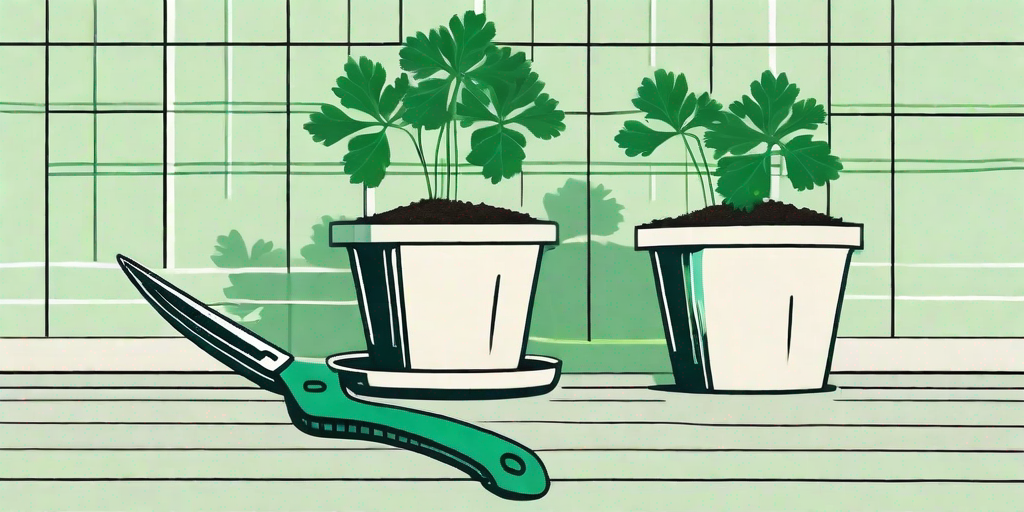
If you're anything like me, you've probably found yourself in the middle of cooking a delicious, spicy dish, only to realize that you're out of cilantro. It's a common predicament, and one that can be easily avoided with a little bit of green thumb magic. In this guide, we'll explore the ins and outs of growing cilantro from cuttings, so you can always have a fresh supply on hand. So, let's cut to the chase and get our hands dirty, shall we?
Understanding Cilantro
Before we dive into the nitty-gritty of growing cilantro from cuttings, it's important to understand what cilantro is and why it's such a beloved herb. Cilantro, also known as coriander, is a versatile herb that's used in a variety of cuisines around the world. Its unique, citrusy flavor adds a refreshing touch to dishes, making it a staple in kitchens everywhere.
But cilantro isn't just a flavor powerhouse. It's also packed with health benefits. It's rich in antioxidants, has anti-inflammatory properties, and can even help lower your blood sugar. So, not only does it make your food taste better, it also makes you healthier. Talk about a win-win!
The Life Cycle of Cilantro
Understanding the life cycle of cilantro is crucial to successfully growing it from cuttings. Cilantro is an annual herb, which means it completes its life cycle in one year. It starts as a seed, grows into a plant, produces seeds, and then dies. This cycle is known as "bolting," and it's a common challenge for cilantro growers.
Bolting is triggered by heat and long days, so cilantro tends to bolt quickly in the summer. Once it bolts, the leaves become bitter and the plant focuses on producing seeds, making it less useful for culinary purposes. But don't worry, we'll cover how to prevent bolting later in this guide.
How to Grow Cilantro from Cuttings
Now that we've covered the basics of cilantro, let's get to the fun part: growing it from cuttings. This is a simple, cost-effective way to multiply your cilantro supply, and it's surprisingly easy to do.
Here's a step-by-step guide to growing cilantro from cuttings:
- Choose a healthy cilantro plant. Look for one with bright green leaves and no signs of disease or stress.
- Cut a 4-6 inch stem from the plant. Make sure to cut just below a node, which is where a leaf joins the stem. This is where new roots will form.
- Remove the lower leaves from the cutting, leaving only a few at the top.
- Place the cutting in a glass of water, making sure the cut end is submerged. Change the water every few days to prevent rot.
- Wait for roots to form. This usually takes 2-3 weeks. Once the roots are 1-2 inches long, the cutting is ready to plant.
- Plant the cutting in a pot filled with well-draining soil. Water it well and place it in a sunny location.
- Wait for the cutting to grow into a new cilantro plant. This usually takes a few weeks. Once the plant is established, you can start harvesting the leaves.
And there you have it! With a little patience and care, you can turn a single cilantro cutting into a lush, productive plant. Now, let's move on to some tips and tricks to help you get the most out of your cilantro plants.
Maximizing Your Cilantro Harvest
While growing cilantro from cuttings is relatively straightforward, there are a few things you can do to ensure a bountiful harvest. Here are some tips to help you maximize your cilantro yield:
- Harvest regularly: Regular harvesting encourages bushier growth, which means more leaves for you. Just make sure not to remove more than one-third of the plant at a time.
- Prevent bolting: As we mentioned earlier, cilantro tends to bolt in hot weather. To prevent this, plant your cilantro in a location with afternoon shade, or use a shade cloth to protect it from the midday sun.
- Keep the soil moist: Cilantro prefers moist soil, so make sure to water your plants regularly. However, avoid overwatering, as this can lead to root rot.
- Fertilize regularly: Cilantro is a heavy feeder, so it benefits from regular fertilization. Use a balanced, organic fertilizer for best results.
By following these tips, you can enjoy a steady supply of fresh, flavorful cilantro all year round. Now, let's tackle some frequently asked questions about growing cilantro from cuttings.
Frequently Asked Questions
Can I grow cilantro indoors?
Absolutely! Cilantro is a great candidate for indoor gardening. Just make sure to place it in a location with plenty of sunlight, like a south-facing window. Also, remember to water it regularly, as indoor plants can dry out quickly.
Why are my cilantro plants turning yellow?
Yellowing leaves can be a sign of several issues, including overwatering, underwatering, or a nutrient deficiency. If your cilantro plants are turning yellow, try adjusting your watering schedule and adding some fertilizer to the soil.
Can I use the seeds from my cilantro plant?
Yes, you can! The seeds of the cilantro plant are known as coriander, and they're used in a variety of dishes. You can also save them to plant next year's cilantro crop.
And there you have it, folks! A comprehensive guide to growing cilantro from cuttings. With a little bit of patience, a dash of care, and a sprinkle of humor, you'll be on your way to a bountiful cilantro harvest in no time. Happy gardening!











